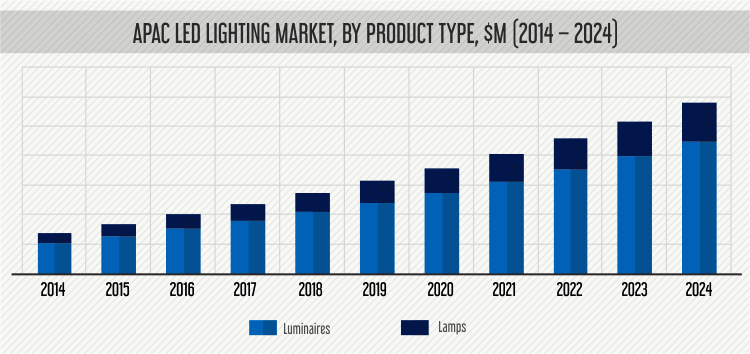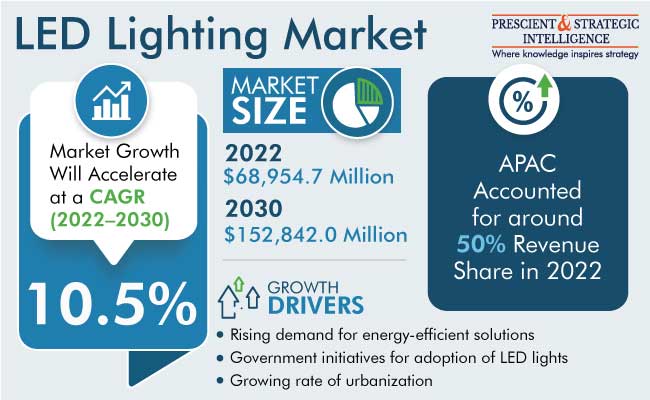Asia-Pacific LED Lighting Market Set to Exhibit Over 10.0% CAGR
The Asia-Pacific (APAC) LED lighting market reached a value of $27.5 billion in 2018 and it is predicted to generate a revenue of $58.0 billion by 2024. In addition to this, the market is predicted to progress at a CAGR of 13.0% between 2019 and 2024. The major factors fueling the expansion of the market are the rapid development of smart cities, the rising enactment of favorable government initiatives regarding energy conservation and energy efficiency in this region.
The governments of many APAC countries are implementing policies for promoting energy efficiency in the region. For instance, many government projects such as the Unnat Jyoti by Affordable LEDs for All (UJALA) enacted by the government in 2015, have already been launched in India for promoting energy efficiency in the country. Furthermore, the government began the Street Light National Programme (SLNP) in 2015 for promoting energy efficiency in the country.
This program was aimed at replacing 35 million conventional lights in the country with LED lights. Apart from the Indian government, the Chinese and the Australian governments are also implementing policies for promoting the usage of energy-efficient LED street lights in the country. Depending on product type, the market is divided into luminaires and lamps. Between the two, the luminaires category held higher share in the market in the years gone by.
This was because of the huge requirement for LED lighting fixtures, on account of the construction of commercial buildings and residential houses in the region. Furthermore, the Asia-Pacific LED lighting market is classified into retrofit and new installation, on the basis of installation type. Of these, the new installation category registered higher growth in the market during the past few years, due to the implementation of several government initiatives regarding the usage of LED lights, especially in China and India.
When indoor LED lighting application is taken into consideration, the APAC LED lighting market is categorized into commercial, industrial, and residential. Out of these, the commercial category held the highest share in the market during the past few years, as per the observations of P&S Intelligence, a market research company based in India. This category includes retail, offices, hospitality and tourism, government, hospitals, banking, financial services, and insurance (BFSI), transportation, and education.
The growth of this category is caused because of the enactment of favorable government initiatives regarding the usage of LED lights in commercial spaces, especially in India, China, Australia, and Japan. Depending on industrial LED lighting, the market is classified into automotive, chemicals and pharmaceuticals, energy and utilities, food and beverage, oil and gas, telecom, textile, mining, and electronics and semiconductors. Amongst these, the energy and utilities category will demonstrate the fastest growth in the market in the forthcoming years.
Hence, it can be said with full confidence that the market will register huge growth in the coming years, mainly because of the rising implementation of favorable government policies regarding energy-efficiency and energy conservation and the rapid development of smart cities in various countries of the region.
Read More: https://www.psmarketresearch.com/market-analysis/apac-led-lighting-market
The Asia-Pacific (APAC) LED lighting market reached a value of $27.5 billion in 2018 and it is predicted to generate a revenue of $58.0 billion by 2024. In addition to this, the market is predicted to progress at a CAGR of 13.0% between 2019 and 2024. The major factors fueling the expansion of the market are the rapid development of smart cities, the rising enactment of favorable government initiatives regarding energy conservation and energy efficiency in this region.
The governments of many APAC countries are implementing policies for promoting energy efficiency in the region. For instance, many government projects such as the Unnat Jyoti by Affordable LEDs for All (UJALA) enacted by the government in 2015, have already been launched in India for promoting energy efficiency in the country. Furthermore, the government began the Street Light National Programme (SLNP) in 2015 for promoting energy efficiency in the country.
This program was aimed at replacing 35 million conventional lights in the country with LED lights. Apart from the Indian government, the Chinese and the Australian governments are also implementing policies for promoting the usage of energy-efficient LED street lights in the country. Depending on product type, the market is divided into luminaires and lamps. Between the two, the luminaires category held higher share in the market in the years gone by.
This was because of the huge requirement for LED lighting fixtures, on account of the construction of commercial buildings and residential houses in the region. Furthermore, the Asia-Pacific LED lighting market is classified into retrofit and new installation, on the basis of installation type. Of these, the new installation category registered higher growth in the market during the past few years, due to the implementation of several government initiatives regarding the usage of LED lights, especially in China and India.
When indoor LED lighting application is taken into consideration, the APAC LED lighting market is categorized into commercial, industrial, and residential. Out of these, the commercial category held the highest share in the market during the past few years, as per the observations of P&S Intelligence, a market research company based in India. This category includes retail, offices, hospitality and tourism, government, hospitals, banking, financial services, and insurance (BFSI), transportation, and education.
The growth of this category is caused because of the enactment of favorable government initiatives regarding the usage of LED lights in commercial spaces, especially in India, China, Australia, and Japan. Depending on industrial LED lighting, the market is classified into automotive, chemicals and pharmaceuticals, energy and utilities, food and beverage, oil and gas, telecom, textile, mining, and electronics and semiconductors. Amongst these, the energy and utilities category will demonstrate the fastest growth in the market in the forthcoming years.
Hence, it can be said with full confidence that the market will register huge growth in the coming years, mainly because of the rising implementation of favorable government policies regarding energy-efficiency and energy conservation and the rapid development of smart cities in various countries of the region.
Read More: https://www.psmarketresearch.com/market-analysis/apac-led-lighting-market
Asia-Pacific LED Lighting Market Set to Exhibit Over 10.0% CAGR
The Asia-Pacific (APAC) LED lighting market reached a value of $27.5 billion in 2018 and it is predicted to generate a revenue of $58.0 billion by 2024. In addition to this, the market is predicted to progress at a CAGR of 13.0% between 2019 and 2024. The major factors fueling the expansion of the market are the rapid development of smart cities, the rising enactment of favorable government initiatives regarding energy conservation and energy efficiency in this region.
The governments of many APAC countries are implementing policies for promoting energy efficiency in the region. For instance, many government projects such as the Unnat Jyoti by Affordable LEDs for All (UJALA) enacted by the government in 2015, have already been launched in India for promoting energy efficiency in the country. Furthermore, the government began the Street Light National Programme (SLNP) in 2015 for promoting energy efficiency in the country.
This program was aimed at replacing 35 million conventional lights in the country with LED lights. Apart from the Indian government, the Chinese and the Australian governments are also implementing policies for promoting the usage of energy-efficient LED street lights in the country. Depending on product type, the market is divided into luminaires and lamps. Between the two, the luminaires category held higher share in the market in the years gone by.
This was because of the huge requirement for LED lighting fixtures, on account of the construction of commercial buildings and residential houses in the region. Furthermore, the Asia-Pacific LED lighting market is classified into retrofit and new installation, on the basis of installation type. Of these, the new installation category registered higher growth in the market during the past few years, due to the implementation of several government initiatives regarding the usage of LED lights, especially in China and India.
When indoor LED lighting application is taken into consideration, the APAC LED lighting market is categorized into commercial, industrial, and residential. Out of these, the commercial category held the highest share in the market during the past few years, as per the observations of P&S Intelligence, a market research company based in India. This category includes retail, offices, hospitality and tourism, government, hospitals, banking, financial services, and insurance (BFSI), transportation, and education.
The growth of this category is caused because of the enactment of favorable government initiatives regarding the usage of LED lights in commercial spaces, especially in India, China, Australia, and Japan. Depending on industrial LED lighting, the market is classified into automotive, chemicals and pharmaceuticals, energy and utilities, food and beverage, oil and gas, telecom, textile, mining, and electronics and semiconductors. Amongst these, the energy and utilities category will demonstrate the fastest growth in the market in the forthcoming years.
Hence, it can be said with full confidence that the market will register huge growth in the coming years, mainly because of the rising implementation of favorable government policies regarding energy-efficiency and energy conservation and the rapid development of smart cities in various countries of the region.
Read More: https://www.psmarketresearch.com/market-analysis/apac-led-lighting-market
0 Комментарии
0 Поделились
0 Отзывы





